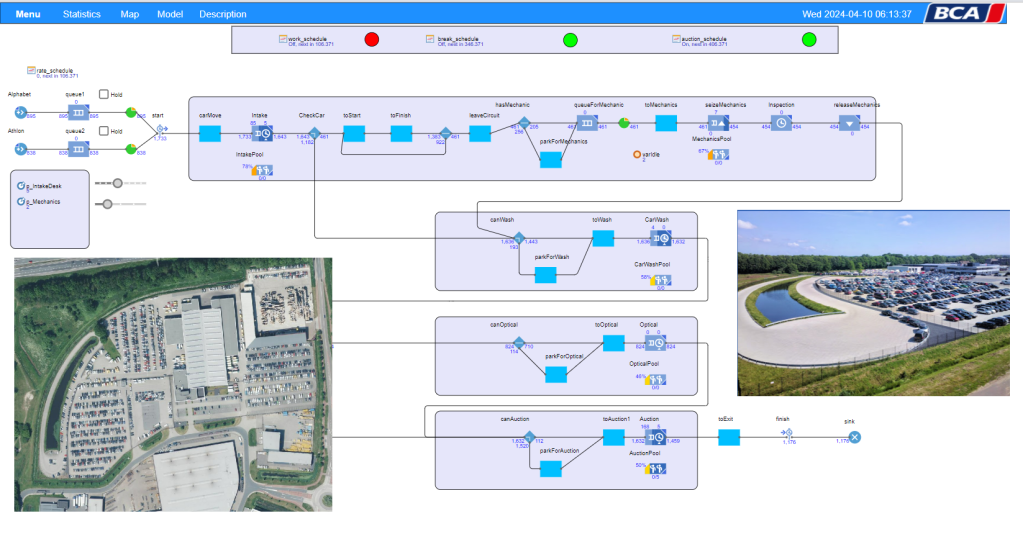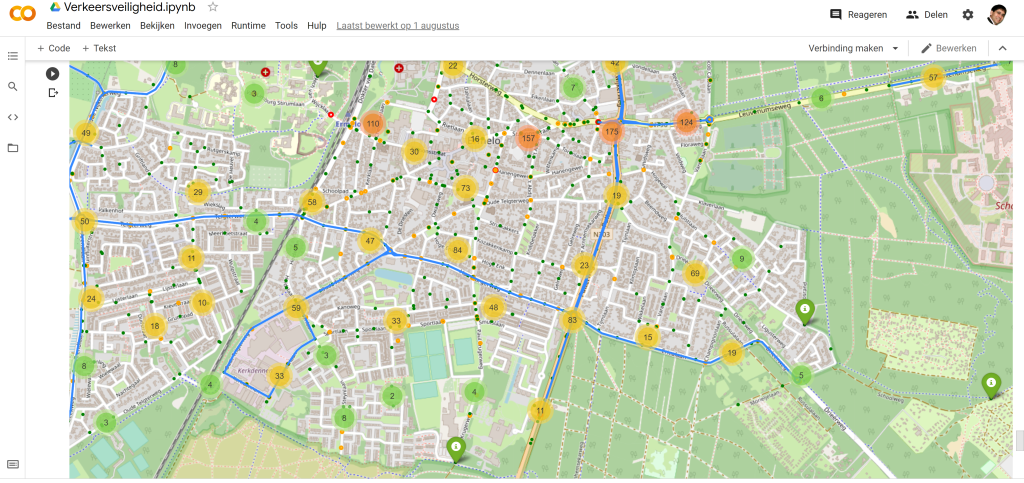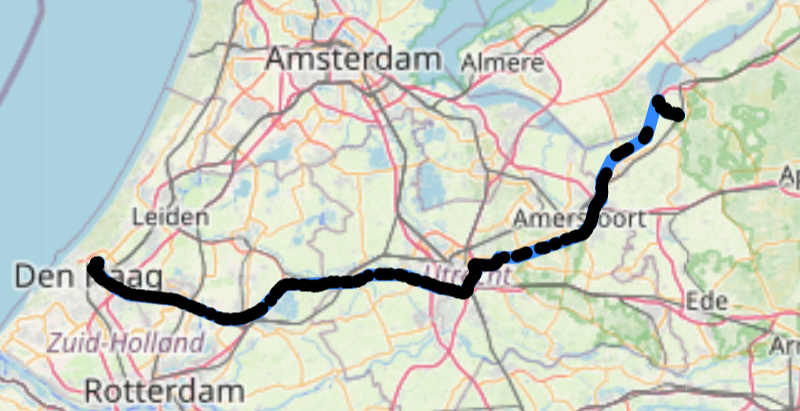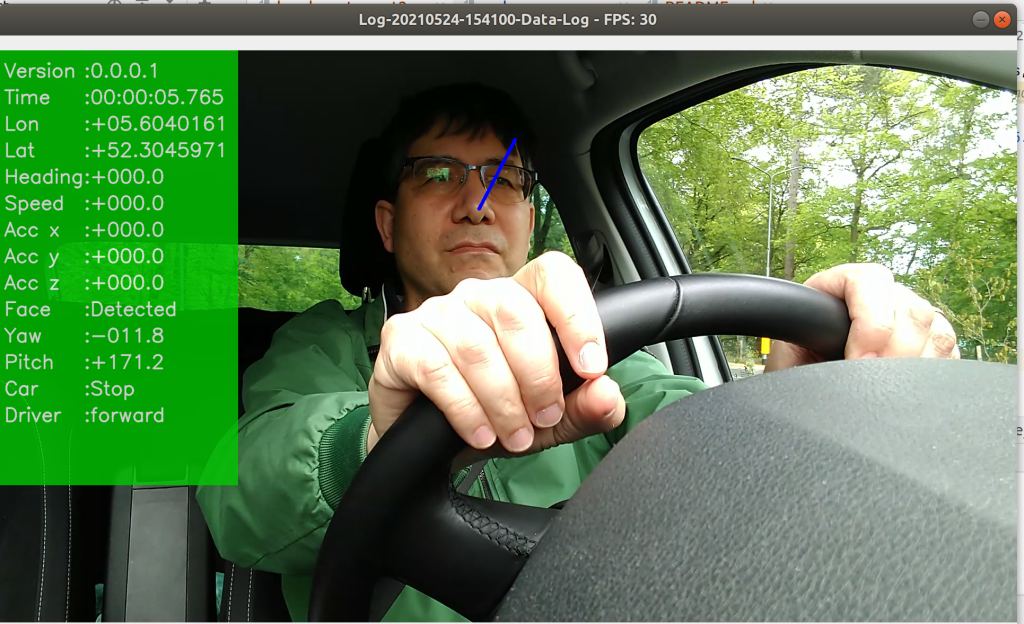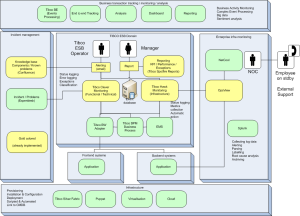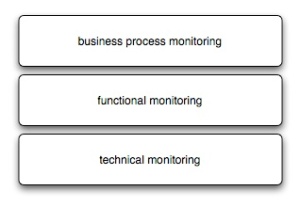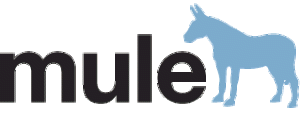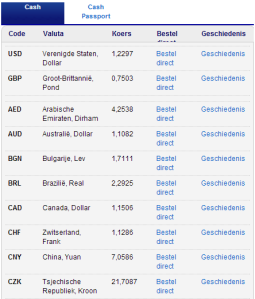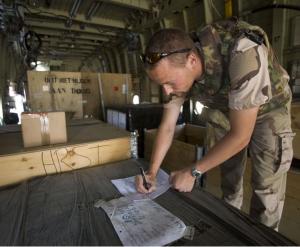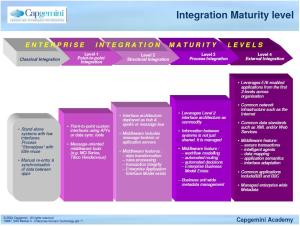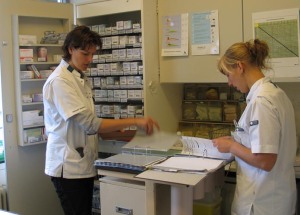Op het blog van vandaag neem ik jullie mee naar Barneveld, waar het online veilingbedrijf BCA jaarlijks meer dan 50.000 voertuigen veilt. Het assortiment is breed: van auto’s tot vrachtwagens en motoren. Na een bezoek aan het bedrijf groeide mijn fascinatie voor hun bedrijfsprocessen. Hoe zou een dag daar eruitzien? Geïnspireerd door deze vraag, ben ik een simulatiemodel gaan ontwikkelen om het bedrijfsproces beter te begrijpen.
Continue readingProjects
Overview of my experience as an IT professional
Helpt een slimmer CV?
Een goede indruk maken op potentiële werkgevers of opdrachtgevers is essentieel als je een nieuwe baan of opdracht zoekt. Daarvoor heb je een CV nodig dat aansluit bij je doel en je kwaliteiten laat zien. Maar hoe houd je je CV up-to-date en relevant voor elke sollicitatie? Een zoektocht naar een praktische oplossing.
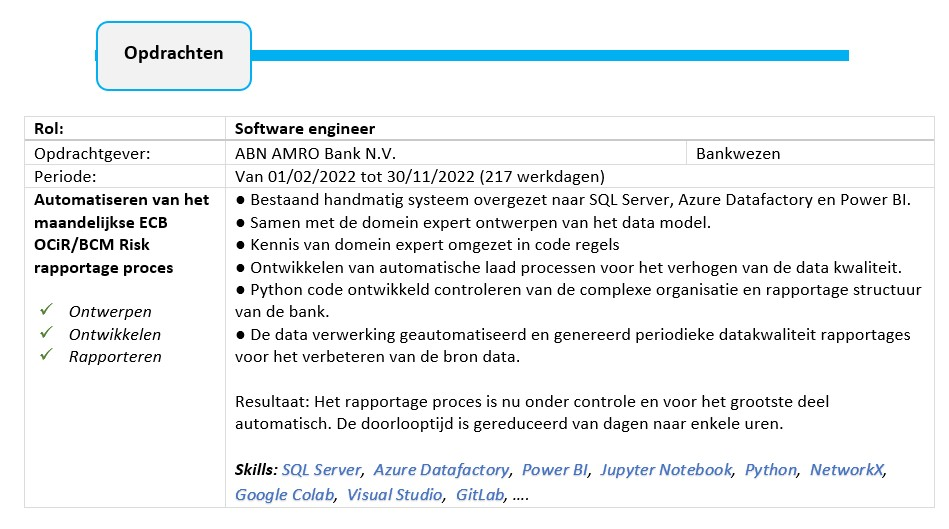
Using GPT-3 for business applications
In this article I describe what GPT-3 is, the business case and a project that im currently working on.
GPT-3 is a wonderful new AI technology for handling text. Translation, question answering, summarization, and fact extraction can all be handled more effectively with the use of GPT-3. You don’t need to be an expert in machine learning technology to take advantage of this new AI technology – simply write simple text instructions like “Please summarise the following text.”
How can we use GPT-3 for business applications? To demonstrate I created a free account on openai.com and asked GPT-3 to help me to write this article together.
Continue readingVerkeersveiligheid in mijn buurt en wat je er zelf aan kan doen
Hoe veilig is mijn buurt? Zijn er gevaarlijke wegen, kruispunten en oversteekplaatsen. Hoe kan ik mijn kinderen veilig naar school laten fietsen. En wat kan ik zelf doen om de veiligheid te verbeteren. Deze vragen rond de thema’s verkeersveiligheid zijn te beantwoorden als je beschikt over de juiste informatie. De overheid, gemeentes en grote bedrijven beschikken over die informatie, maar helaas is die niet voor iedereen even toegankelijk. Je mag erop vertrouwen dat de gemeente het beste doet voor jouw buurt maar als je actief betrokken wilt zijn zal je zelf op zoek moeten gaan.
In dit artikel zoek ik naar data over de verkeersveiligheid in mijn buurt en straat. Zodat burgers met behulp van data en visualisatie tools zelf de antwoorden kunnen vinden.
Continue readingMaak van veilig naar je werk rijden een serious game
Autorijden veiliger maken voor iedere automobilist en weggebruiker met serious gaming. Elke dag rij ik met de auto naar mijn werk bij de ANWB in Den Haag, een rit van meer dan 100 km door de bebouwde kom en over de snelweg. Goed en veilig autorijden is best moeilijk. In dit artikel presenteer ik een serious game aanpak waardoor ik steeds veiliger ga rijden. Deze werkwijze is onderdeel van DriverCoach een systeem voor veilig rijden.
De DriverCoach in de eerste versnelling
In dit artikel beschrijf ik het onderzoeksproject DriverCoach voor meer verkeersveiligheid door gedragsbeïnvloeding en de tot nu toe bereikte resultaten.
Elke dag rij ik net als vele anderen in mijn auto naar mijn werk. Maar doe ik dat wel veilig, economisch en efficiënt? Het onderzoeksproject DriverCoach wil daar een antwoord op geven. Het einddoel is een betaalbaar systeem voor iedere automobilist dat de verkeersveiligheid bevorderd.
AI based personal driving coach can make driving 57% safer

Of all car accidents 94 percent are caused by driver error and 57 percent by distracted driving. A system that helps the driver to focus its attention on driving can reduce injuries and damages.
The driver coach system will check for 3D aspects:
- Distractions (eating, drinking, phone usage)
- Driving maneuvers (situational awareness, mirror checking)
- Drowsiness (tired driver warning)
The objective is to make driving safer by developing an affordable personal driving coach.
Did you find what your where looking for?

Are you looking for information in tons of documents but struggle to find it? I have the same problem. So I started a literature search and setup a Data Science project on Semantic Search. To verify i’m heading in the right direction I did a POC on finding interesting phrases in the Holy Bible. This blog post is the first in a series, describes the outlines of the project and show the first result.
Continue readingProcess mining and analysis
How much do we really know about our business processes:
- Number of started / completed / aborted processes
- Success / failure rate
- Turnaround time
- Root cause of failures
During my latest customer engagement i used some basic process mining and analysis techniques. Process mining is a process management technique that allows for the analysis of business processes based on event logs. The basic idea is to extract knowledge from event logs recorded by an information system. Process mining aims at improving this by providing techniques and tools for discovering process, control, data, organizational, and social structures from event logs. Continue reading
How to Monitoring TIBCO ESB
TIBCO Enterprise Service Bus provides a complete set of ESB products, these products need to be combined into a solution architecture. For my current customer I designed and implemented the following monitoring and reporting solution that resulted in a significant reduction of business process exceptions.
Types of Monitoring
Monitoring and Reporting
Why do we need it?
 Monitoring and Reporting is not just an add-on to the business functionality that can be added long after the design of business functionality has finished. It is an essential element of the architecture and design. It provides you with all the tools and information required to run business process as expected.
Monitoring and Reporting is not just an add-on to the business functionality that can be added long after the design of business functionality has finished. It is an essential element of the architecture and design. It provides you with all the tools and information required to run business process as expected.
Social Network analysis
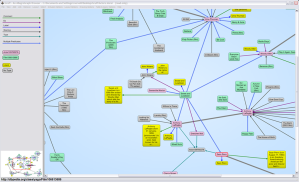 Once you have setup a Social Network with an active community it is time to take a better look at what goes on inside the network. Every network has been setup to serve one or more goals like community building, knowledge sharing and social interaction. How can we determine if our Social Network is sucesfull and how to steer it in the right direction? Continue reading
Once you have setup a Social Network with an active community it is time to take a better look at what goes on inside the network. Every network has been setup to serve one or more goals like community building, knowledge sharing and social interaction. How can we determine if our Social Network is sucesfull and how to steer it in the right direction? Continue reading
Rijkswaterstaat “Enterprise Service Bus”
I was asked to take care of the design and implementation of the Enterprise Service Bus and deliver a complete solution based on Mule ESB. The project was a real challenge because of the short delivery time.
- Implement an Enterprise Service Bus based on Mule ESB, JBoss Application Server and HornetQ Messaging
- Install the software in a VMWare Redhat Linux environment
- Define guidelines and best practices
- Provide documentation (installation, maintenance, development)
- Designed and build integrations:
- Idenity management (OpenAM)
- Electronic data exchange (Digikoppeling)
The project was delivered just in time.

Canon Europe
![]() The One Canon Programme of Canon Europe has the ambition to redesign and improve its worldwide IT services and at the same time lower cost by outsourcing Functional Application Management. The new IT solutions where developed by multiple suppliers (Capgemini, Logica, Deloitte and IBM) and the new IT environment was outsourced to Capgemini India. Because of a best of breed approach several applications needed to be integrated with middleware IBM WebSphere Process Server and ETL tools.
The One Canon Programme of Canon Europe has the ambition to redesign and improve its worldwide IT services and at the same time lower cost by outsourcing Functional Application Management. The new IT solutions where developed by multiple suppliers (Capgemini, Logica, Deloitte and IBM) and the new IT environment was outsourced to Capgemini India. Because of a best of breed approach several applications needed to be integrated with middleware IBM WebSphere Process Server and ETL tools.
Mr Ritter was asked to participate in this programme because of his experience with middleware and outsourcing.
Tasks and duties:
- Collect and catalog all existing and missing knowledge and documentation on the newly build middleware solutions
- Support the knowledge transfer to a Managed Resources team from India
- Define requirements for a error handling and monitoring system
- Responsible for setting up and providing production support during the transition period
- Handle incidents (HP Openview)
- Analyse and fix problems in WebSphere Process Server code (mediations, Java programming)
- Create daily reports on production errors in ETL tooling
ING Insurance Central Europe “ICE project”
The “Vision for Growth” program includes developing and deploying an integrated solution for ING Insurance for all of Europe and Russia. The ILIS/ESB project is part of this program and delivers a TIBCO software-based service layer.
A small team of two was assigned to develop integrations and configure the Enterprise Service Bus. The TIBCO software had to be installed on three separate Linux servers in a DEV/TEST/ACC/PROD environment. The project team decided that installation and configuration of every environment by hand would take too much time and an automated installation procedure was needed. Another challenge was that the required server hardware was not available on time.

Mr Ritter came up with the following solution:
- use RPM as a fully automated installation solution.
- using a virtual server environment as a temporary replacement for the missing hardware
Mr Ritter installed a virtualization product called VirtualBox on his laptop that allows to run a virtual Linux server. This product allows him to simulate the deployment environment and saved the project lot of time.
Mr Ritter was responsible for installation, configuration and testing:
- Installation and configuration
- Configuration of TIBCO BusinessWorks software
- Designing and developing an automatic installation method based on Redhat Package Manager (RPM) on Linux servers
- Designing and developing a scripted service deployment method
- Organizing security (role-based, PKI Certificates)
- Implemented SELinux security policies
- Setting up a logging framework for functional errors
- Testing
- Documentation of installation, configuration and deployment procedures
Fortis Bank Nederland “Enterprise Service Bus”
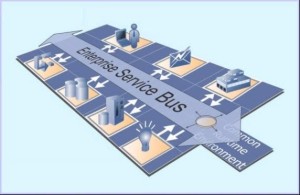 Due to the expected integration of Fortis with ABN-AMRO the need arose to be prepared for integration. The ESBM project was setup to deliver an Enterprise Service Bus based on WebServices with Soap over http, WS-Security and MQSeries.
Due to the expected integration of Fortis with ABN-AMRO the need arose to be prepared for integration. The ESBM project was setup to deliver an Enterprise Service Bus based on WebServices with Soap over http, WS-Security and MQSeries.
Mr Ritter was asked to design and develop an ESB implementation with the following requirements:
- Based on the IBM Websphere Messagebroker platform
- Define modulair building blocks which can be easily replaced and changed
- Support for webservices (WS-Security)
- Http and MQ transport
- Support for error tracking and tracing
In two months he delivered a proof of concept version showing its ability to integrate an Oracle application with a mainframe application. During the demonstration performance test where executed using the SoapUI WebService test tool.
Fortis Bank Nederland “Rates list”
The “Koerslijst” (Rates list) is an important system for the daily publication of the Fortis exchange rates, Euribor, Libor, financial market prices and prices of precious metals to all offices and external clients. This data is collected daily from several sources such as Reuters and processed by hand using spreadsheets. Due to new regulations the procedure needed to be upgraded to be more secure and better auditable.
A new system has been setup based on a JBoss Application Server together with Open Source software like the Spring framework, Maven, and JasperReport
- Mr Ritter designed the new system using with special awareness of security, data quality and traceability aspects.
- Mr Ritter also developed parts of the program code for the production of reports with JasperReports.
The system is now in daily use for Fortis and GWK-Travelex.
Fortis Bank Nederland Global Markets “Equity Brokerage”
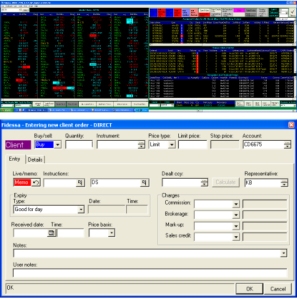
Fidessa Trading
Because of the separation of Fortis new computer systems had to be developed in a short period of time. The Equity Brokerage project involved integrating a new trading system front-end hosted by Fidessa in England with the back office of Fortis in the Netherlands.
Mr Ritter designed and implementated the middleware based on an IBM WebSphere MessageBroker processing SWIFT FIN messages. He also designed and build a Java based Fidessa Gateway application to communicate with the Fidessa host using a propriertary Fidessa protocol. All incoming trades had to be transformed into MQSeries XML messages. This gateway was designed and build in two weeks, the project was completed within the expected time period.
Fortis Bank Nederland “Martini Trading System”
A new securities trading system is implemented that provides the trader with a better view on his position. The SunGard Martini front-end is hosted in England and connects to the Fortis backend systems in Belgium. Mr Ritter was asked to design and develop all interfaces based on WebSphere MessageBroker and MQSeries SWIFT messages.
Application monitoring
Soon after a first deployment trial a new requirement for application monitoring on technical and application errors was discovered. The existing tooling for application monitoring (Tivoli) proved not to be sufficient. Brainstorm sessions where held and together with the technical support department a new approach for error handling and transaction monitoring was developed.
Mr Ritter designed a system for collecting, recording and reporting on errors from various online and batch processes based on open source software. This system is able to monitor transactions within the system, collect and analyze the errors, and forward this information by email to the appropriate problem solving group (technical or application support). The current status of transactions and errors can be followed with a webbrowser on a Tomcat web application and transactions restarted. This setup turned out to be a great advantage because during first deployment trials several errors were found and could now be solved before entering production.
ANWB “Summit programme”
 The Dutch ANWB roadservice has started the Summit programme to reorganize its application landscape. Capgemini was involved in the program to build a Siebel CRM solution.
The Dutch ANWB roadservice has started the Summit programme to reorganize its application landscape. Capgemini was involved in the program to build a Siebel CRM solution.
Mr Ritter was asked to assist the Capgemini team by designing and implementing the integration of the Siebel CRM application to other applications using an Enterprise Service Bus (ESB). The design of the ESB was originally assigned to Atos Origin and two candidate middleware vendors competed for the implementation: Oracle Fusion and Progress Sonic ESB. This whole setup resulted in a complex situation with multiple vendors and implementation parties. Mr Ritter took the liberty to propose a design standard for defining services and managed to integrate the Siebel CRM application in 3 days.
Telfort “Replace middleware”
 Telfort is a Dutch telecom provider. A small team of Capgemini consultants was setup to help Telfort deal with an existing integration bus that is no longer able to support the flexibility and scalability requirements of their business. Mr Ritter was assigned as a consultant to the team and helped to prepare a three-day workshop for determining the requirements for a solution, create a transformation plan and select a first proof of concept project.
Telfort is a Dutch telecom provider. A small team of Capgemini consultants was setup to help Telfort deal with an existing integration bus that is no longer able to support the flexibility and scalability requirements of their business. Mr Ritter was assigned as a consultant to the team and helped to prepare a three-day workshop for determining the requirements for a solution, create a transformation plan and select a first proof of concept project.
Delta Lloyd Verzekeringen “FAP”
 Delta Lloyd Insurance launched the FAP project to introduce a new insurance quoting system and asked Capgemini to execute a quick study with a small team of consultants to investigate the possibilities for reuse of existing systems. Mr. Ritter has taken part in this study as a consultant and integration expert to pay attention to the integration of the user interface to the back office systems. Interviews where held and existing documentation read resulting in a report for the board of directors.
Delta Lloyd Insurance launched the FAP project to introduce a new insurance quoting system and asked Capgemini to execute a quick study with a small team of consultants to investigate the possibilities for reuse of existing systems. Mr. Ritter has taken part in this study as a consultant and integration expert to pay attention to the integration of the user interface to the back office systems. Interviews where held and existing documentation read resulting in a report for the board of directors.
Essent Netwerk “De ICT Verbouwing”
 Essent Networks must restructure because of market changes and regulations. A team of Capgemini has executed an architectural study, resulting in an overall architecture proposal.
Essent Networks must restructure because of market changes and regulations. A team of Capgemini has executed an architectural study, resulting in an overall architecture proposal.
The role of Mr. Ritter as a middleware consultant is to define a set of requirements for an EAI/SOA solution and make a recommendation for a product selection. The requirements were collected in 4 weeks during workshops and recorded in a structured and compact PowerPoint presentation and accompanying document. This information will be used in subsequent transformation processes as a basis for a SOA implementation.
Ministerie van Defensie “Transaction Integrity”
The “DienstenCentrum IV-Beheerafdeling” is the central IT department within the Dutch army responsible for keeping the IT systems in good working order. De Dutch army relies on its Websphere MQ infrastructure for integrating all its applications. The need arose to investigate how vulnerable this system is for loss of integrity during a failure. Mr Ritter was hired as an IT Architect he analysed the situation and focussed on transaction integrity for transactions that span multiple systems. He came up with a plan to improve te current situation.
Mercedez Benz CAC “Keep MQ running”
 DaimlerChrysler Customer Assistance Center has a well performing middleware infrastructure to support its 24 hour service based on IBM products as IBM MQSeries en WebSphere Messagebroker. This system was installed in a previous project. Due to a change in support contract the need arised for a new disaster recovery procedure.
DaimlerChrysler Customer Assistance Center has a well performing middleware infrastructure to support its 24 hour service based on IBM products as IBM MQSeries en WebSphere Messagebroker. This system was installed in a previous project. Due to a change in support contract the need arised for a new disaster recovery procedure.
Mr Ritter proposed and implemented a solution and updated all documentation.
Bouwfonds ESB Selection
I am currently involved with Bouwfonds Holding, a leading international property company that boasts a workforce of around 1800 employees, 400 of whom are stationed outside The Netherlands. My engagement with Bouwfonds began with the COBRA project, an ambitious initiative aimed at establishing a robust infrastructure to facilitate financial consolidation, Basel II, and Economic Capital reporting.
In my capacity as a middleware consultant, I was tasked with designing a system capable of aggregating financial information from various sources within the company and directing it towards the central data warehouse. As the project progressed, it became evident to management that a more comprehensive, enterprise-wide solution was necessary. This led to the inception of the “COBRA Connectivity” sub-project, which I spearheaded alongside a colleague from Capgemini. Our mission was to integrate an Enterprise Service Bus (ESB) into the company’s IT landscape, prompting an extensive product selection process enriched by workshops. These workshops provided each business unit within Bouwfonds an opportunity to contribute to the selection criteria, ensuring a solution that resonated with the needs and preferences of all stakeholders.

This collaborative approach culminated in Bouwfonds forging a strategic partnership with Cordys, embarking on the development and implementation of an enterprise-wide connectivity layer. My role then evolved to working in tandem with the Cordys product development department, where I took the lead in designing a Secure File Transfer solution tailored for the financial data needs of Bouwfonds. Moreover, to streamline the financial consolidation process, I developed and implemented a business process model using Cordys BPM.
The Secure File Transfer solution has not only become a proprietary product of Cordys but also serves as a testament to the successful implementation of Cordys technology. This project stands as a showcase of how effective and impactful collaboration between Bouwfonds and Cordys has been in achieving our shared goals.
De Goudse: Infobus
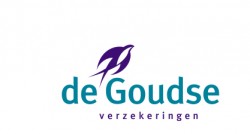 “De Goudse” insurance wants to upgrade its existing IT infrastructure to a enterprise service bus in order to support some newly scheduled projects. Mr Ritter is asked to help with the setup of a integration bus and support the inhouse architect with the design. In addition he has developed a Java based adapter to connect the AS400 insurance application to MQSeries middleware.
“De Goudse” insurance wants to upgrade its existing IT infrastructure to a enterprise service bus in order to support some newly scheduled projects. Mr Ritter is asked to help with the setup of a integration bus and support the inhouse architect with the design. In addition he has developed a Java based adapter to connect the AS400 insurance application to MQSeries middleware.
Ford “Visteon seperation”
 As part of its efforts to separate from Ford, Visteon is undertaking a Clone project to replicate the legacy applications and systems that Ford currently provides to Visteon. Teams are working on an aggressive timeline to separate in 18 months.
As part of its efforts to separate from Ford, Visteon is undertaking a Clone project to replicate the legacy applications and systems that Ford currently provides to Visteon. Teams are working on an aggressive timeline to separate in 18 months.
Mr Ritter was selected for his mainframe skills to participate in the process of testing the mainframe jobs scheduled by a CA7 job scheduler. Besides his main assignment he also assisted in solving some issues with MQseries coomunication on the IBM mainframe.
Capgemini Academy “SOA Solutions for Integration Architecture”
Together with two other colleagues Mr Ritter developed a three-day Capgemini Academy course “SOA Solutions for Integration Architecture. The training includes theory and interactive workshops. Mr Ritter contributed by developing course material based on his practical experience. He acted as a trainer in the first training sessions. This course is still available at the academy.
The training includes:
- Positionering binnen IAF
- System Domain Architectuur
- Legacy structuren and Client/Server, batch georiënteerde systemen
- Multichannel architecturen op basis van Java en .NET
- Technologieën en producten
- Enterprise Domain Architectuur
- Service Oriented Architecture als basis voor loosely coupled architecturen, Messaging and Message Brokers
- Technologieën en producten
- Data-integratie structuren
- Operational Datastore en Data Warehouse
Interpolis Pensioenen “Infobus”
Interpolis Pensioenen has started a 5 year 100M programme for improving and aligning business processes with its vision. Part of this programme is the BIP project that focuses on computer system integration. The IPP Infobus is a service oriented middleware solution based on XML and MQSeries message oriented middleware.
Mr Ritter was responsible for design and implementation of the IPP Infobus that supports Oracle, Siebel and COOL:2E applications on UNIX, Windows 2000 and IBM AS400. This resulted in the following deliverables:
- Design document (requirements, design principles, infrastructure design)
- Interpolis Bericht Formaat (a Company wide standard message format)
- Adapter framework
After an intensive study Mr Riter decided that off the shelf middleware adapters could not meet the customers demands. A custom build Java adapter was built to connected all these applications to the MQSeries middleware. Customer employees were trained and tools were installed to enable remote support. Java was chosen for its ability to run on all required platforms and the availability of useful Open Source Software (xml parsers, logging, remote maintenance). As proof of concept of the IPP Infobus services on a AS400 where exposed by the adapter.
IB-Groep “Troubleshoot E-Service”
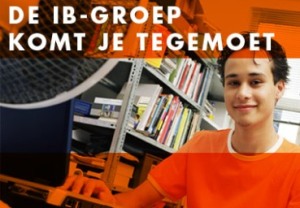
The IB-Groep is a governmental organization for student administration. The IB-Groep E-service offers direct web access to student load information. The end users on the website complained about problems getting to their data. I was asked to find the root cause of these problems.
The website connects to their back office systems using an MQSeries-based middleware infrastructure running on IBM mainframe, AS400, and Windows 2000. They have been experiencing a variety of errors including lost messages, timeouts, and lost connections. I need to quickly find the cause of these problems, provide solutions, and advise on infrastructure improvements.
How to identify the root cause of the problem? In the absence of sufficient data and monitoring, I took the initiative to establish a measurement system to gather information on the current system behavior. This encompassed network and computer system traces, as well as overviews of response times. I then presented this information to management in a daily spreadsheet, highlighting system availability and periods of outage. This proactive approach yielded valuable results. Upon analyzing the collected data, I confidently identified a serious network issue, internal system performance problems, and non-compliance with the Service Level Agreement with our external mainframe supplier.
Meetings were arranged with the external supplier to optimize the system. Network and system experts were brought in to identify and address any performance bottlenecks. I facilitated collaboration among these experts and conducted thorough testing. Every issue was successfully identified and resolved. Subsequently, I authored a comprehensive report detailing the current system status and outlining the necessary improvements.
Delta Lloyd-Ohra “Connect”
Delta Lloyd-Ohra is reorganizing its banking activities to cut down costs and reduce complexity. The Connect project focusses on the integration of the new Globus application ((Temenos) with existing systems and interfaces(Exact, SWIFT, Interpay, Telekurse and mainframe).
Mr Ritter is responsible for design and implementation of the MQSeries middleware with special attention for security. The integration architecture is based on message oriented middleware supplied by IBM (MQSeries). To enable secure transfer of files a custom-made filea dapter was designed and build by Mr Ritter. Data transfer security and authentication is based on a Java Cryptography implementation.
The system was delivered on time, taken into production and approved by the customer.
Mercedes Benz Customer Assistance Center “Compass Telematics”
Mercedes Benz Customer Assistance Center offers its high-value customers a 24-hour assistance service via its European Call Centre in Maastricht. Compass Telematics is a new service where a driver can set up an emergency call by pressing an alarm button. The system is based on an in-car phone system built by T-Systems and integrated with car electronics such as the diagnostic system, onboard computer, and GPS navigation. Via text messaging, the car can also send messages to the call center autonomously when an accident is detected. The Compass Telematics project includes setting up the technical infrastructure for linking the communications equipment in the car with the Avaya telephony system and the back office (Siebel Call Centre).
My role is to design and implement the infrastructure for integrating all system components based on IBM MQSeries and MQSI Message Broker. In June this system was successfully taken into production. Management decided to use the new architecture for further integration projects within Mercedes-Benz. A new project for integration with UK trucking in England is considered.
ING Bank “SAMBO”
Design and implementation of a system for generating management reports for a Project Management System (SAMBO). The Project Managament Systems administers information on project buget and progress. New projects will be judged by the IT Governance Board (ITGB) on a monthly basis.Data is extracted from a wide range of applications (Lotus Notes, CICS, Access en Oracle) and stored in a central Oracle database and processed by Business Objects.
Mr. Ritter helped to setup all data connections between the reporting application and the datasources.
Philips Semiconductors “SPEED”
![]() In 2000, Philips decided to phase in an SAP-ERP system for all its manufacturing sites worldwide. A program, SPEED (Superior Production
In 2000, Philips decided to phase in an SAP-ERP system for all its manufacturing sites worldwide. A program, SPEED (Superior Production
Execution through ERP Deployment), was launched. The first phase that enabled worldwide integration of SAP ERP and legacy systems in the Netherlands, France, Thailand, Hongkong and China.
Mr Ritter worked in close cooperation with the main architect responsible for designing the messaging architecture and system management environment for the world-wide SAP implementation. The resulting architecture is based on a TIBCO Rendezvous publish/subscribe implementation.
- In order to full fill the project requirements the standard TIBCO Message Broker was enhanced by Mr Ritter with extra functionality for message integrity checking based on XML schemas.
- Mr Ritter setup a system monitoring system based on TIBCO Hawk
- Mr Ritter also fixed a blocking problem with the Message Broker software by patching the TIBCO source code and donated the code to the TIBCO support group.
The initial rollout was successful and the project continued to its next planned phase. Press release: ss_Philips_SPEED__Accelerating_Global_Integration
Winterthur (Reaal)
Winterthur is looking for solutions to integrate its existing mainframe applications with the internet for building new Business to Consumer applications. The goal of the pilot project was to determine the right direction and final requirements for legacy enablement. Mr Ritter was responsible for designing and developing the complete solution based on IBM MQSeries middleware and the MQSI Message Broker. A proof of concept was delivered and demonstrated to management.
ASR AORTA project
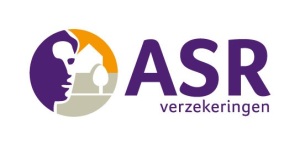 The AORTA project is a result of the merger between two insurance companies: “de Amersfoortse” and “Stad Rotterdam”. AORTA is a message based solution for integrating applications on different types of computing environments: Siemens BS2000, IBM VM/VSE AIX, NT and Unisys. The final solution is based on IBM MQSeries, MQSI Message Broker and XML message formats.
The AORTA project is a result of the merger between two insurance companies: “de Amersfoortse” and “Stad Rotterdam”. AORTA is a message based solution for integrating applications on different types of computing environments: Siemens BS2000, IBM VM/VSE AIX, NT and Unisys. The final solution is based on IBM MQSeries, MQSI Message Broker and XML message formats.
Mr Ritter was responsible for the design and implementation of all message broker. interfaces and the adapters on the Siemens mainframe. This included building COBOL batch and online interfaces to IDMS applications. A special solution was required for the IDMS applications. The IDMS application could not directly interface with MQSeries because IDMS is by design not allowed to wait for MQ timeouts. Mr Ritter found a workaround by implementing the IDMS interface as a native print spooler application. Now the IDMS application can print to a virtual printer destination representing a queue destination.
Nederlandse Vereniging van Makelaars
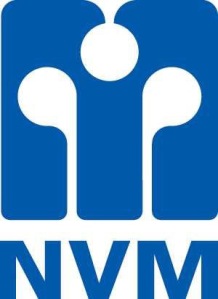 The NVM is the Dutch organisation of real estate brokers. Their administrative systems are based on Progress 4GL database software and required an upgrade.
The NVM is the Dutch organisation of real estate brokers. Their administrative systems are based on Progress 4GL database software and required an upgrade.
Mr Ritter was responsible for redesigning the existing code base in order to improve maintainability. He checked all code for inconsitencies and applied corrections. He also tuned and cleaned the database. during his data analysis he found ommisions in membership data that resulted in the recovery of missed income worth 60.000 euro.
Ministry of Justice Anti money laundering

Money laundering
Project MOT
In 1994 the Dutch government adopted new Money laundering legislation (Wet MOT). Meldpunt ongebruikelijke transactie (notification center unusual transactions). The ministry of Justice requested PinkRoccade to build the new MOT system. Sales engineers at PinkRoccade had heard about the Omega framework and decided to re-use this framework.
A team was setup with a project lead, Mr Ritter as lead designer and two Delphi developers. The project was delivered succesfully and a second project immediately followed.
Project Vennoot
The Dutch government department of Justice is responsible for tracking and investigating the startup of new companies in order to prevent fraud. The Vennoot system is a database where information concerning startups is collected from numerous sources.
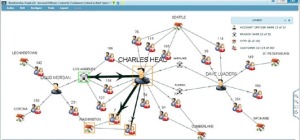 Mr Ritter was responsible for the technical design and implementation of this new system. The system collects information from databases and connects to external mainframe systems from the department of justice for retrieving criminal records. The system is based on an object oriented component framework that Mr Ritter developed in a previous project (Omega). The Vennoot system was successfully delivered.
Mr Ritter was responsible for the technical design and implementation of this new system. The system collects information from databases and connects to external mainframe systems from the department of justice for retrieving criminal records. The system is based on an object oriented component framework that Mr Ritter developed in a previous project (Omega). The Vennoot system was successfully delivered.
Trendsoft Omega project
 Omega is a Dutch company based in Amsterdam that specializes in software for e-learning and electronic examination applications. The ITSI/OTIS system is a advanced interactive multi-media application for electronic examination. The system is initialy developed for INNOVAM an automotive branch organisation to instruct car mechanics. In the preparation phase an exam is developed by creating examination subjects and randomly selecting questions, pictures and video fragments from a database by an expert with the help of an examination design tool. At the examination date the students have their own Windows PC and examination application.
Omega is a Dutch company based in Amsterdam that specializes in software for e-learning and electronic examination applications. The ITSI/OTIS system is a advanced interactive multi-media application for electronic examination. The system is initialy developed for INNOVAM an automotive branch organisation to instruct car mechanics. In the preparation phase an exam is developed by creating examination subjects and randomly selecting questions, pictures and video fragments from a database by an expert with the help of an examination design tool. At the examination date the students have their own Windows PC and examination application.
The expert constructs exam items using a graphic editor palet containing visual elements that can be combined:
- Information:
- Text
- Image
- Video
- Sound
- Question type:
- Multiple-choice (single and multiple answer)
- Open question
- Matching
- True/False
- Click on area
 Mr Ritter designed the software to support this system and created an unique generic application framework that features:
Mr Ritter designed the software to support this system and created an unique generic application framework that features:
- Object oriented
- Object database persistence
- Object visualisation
- visual inheritance
The examination system was build with a three man team and implemented in Borland Delphi, the objects where stored in a Oracle database. The so called “Omega framework” proved to be very successful and is now a showcase of innovative design for the Trendsoft company.
RAET Mainframe services
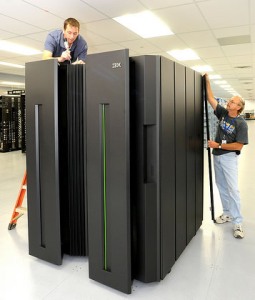 Computer Science Coorporation is based in Apeldoorn (formerly named RAET) and supports a large IBM mainframe environment for running “in service” applications.
Computer Science Coorporation is based in Apeldoorn (formerly named RAET) and supports a large IBM mainframe environment for running “in service” applications.
Mr Ritter started as a Network engineer in a SNA/VTAM network environment. He developed maintenance procedures based on TSO/ISPF scripts, created automated maintenance jobs, simplified and tuned network topology. This resulted in improved network performance and he reduced the procedure for introducing new network users from one week to 6 hours. Besides his daily job as a Network engineer he also worked on a internal project “Release”. Release is now the required procedure for the installation of new software and promotion through the test and production phases.
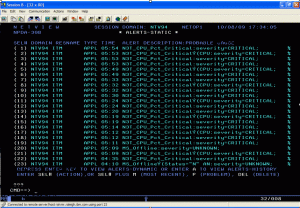
Netview NPDA
His last project is the introduction of automated operations using IBM Netview application. This resulted in a now fully operational Automated Operations systems based on Netview. This system is activated at system startup (IPL) and controls and monitors all application activity on the mainframe including the external network.

The main console

The bridge
Hospital pharmacy “Diaconessen Ziekenhuis Meppel” (Trainee)
This was an exiting assignment. During my study as a bachelor in computer technology I had to get some hands-on experience in a business environment. So i worked for 4 months as an intern for a hospital pharmacy to maintain and improve their computer system (Digital PDP11 MUMPS) used for stock keeping of medical supplies.
First i had to learn programming in MUMPS (Massachusetts General Hospital Utility Multi-Programming System) that is the most efficient language in the world because every statement can be abbreviated to just a single letter. You can imagine what that will do for source code readability.
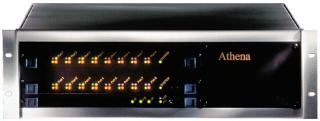
X25-PAD Device
Together with Interpharm a well known pharmaceutical supplier I designed and implemented an fully automated ordering system based on a BSO EDI protocol where data was exchanged via a X.25 protocol on a private network (Datanet-1 by Dutch PTT). All software for data communication, message handling and updating the database had to be written in MUMPS by myself. A real challenge was to get the communications going because X25 protocol was a new technology. The project was completed within three months. To test the system I ordered some coughing potion and the next day it arrived as requested.
The head pharmacist was very happy with my work and i actually received a salary for my internship. The ordering system was demonstrated by me on a national meeting of pharmacists.
